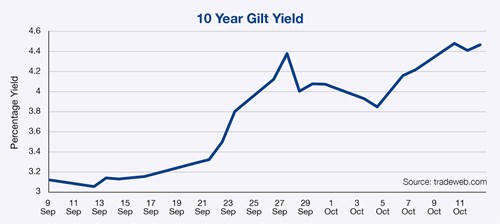

"Say Hello to
Independent Financial Advice"
0191 281 8811
Client Login
0191 281 8811
Client Login
Doug's Digest : Unintended consequences
For over a year now the high level of inflation has been a focus of attention for economists around the world.
Initially, this was expected to be transitory, as economies around the world opened up again following Covid lockdowns, while supply lines were not up to speed for the same reason. The start of the conflict in Ukraine changed this, however, with shortages in energy and commodities moving the drivers behind inflation from demand to supply and making higher inflation more persistent.
Ever since, central banks have been following their mandates to keep inflation under control, including the Bank of England who have raised interest rates from 0.1% in December last year, to 2.25% in September this year. The idea is that as interest rates rise, not only are we encouraged to save money in the bank,
earning higher levels of interest, but also have to commit more money to financing existing debt, such as mortgages or business loans, so have less capital to spend. Spending less reduces demand for goods and services, preventing manufacturers and providers from raising their prices further if they wish to stay competitive in a smaller market.
This was thrown into turmoil in September, however, when the (then) new Chancellor presented the UK government’s minibudget, revealing personal and corporate tax cuts along with reversing the National Insurance increase, on top of introducing an energy price cap. All these policies were viewed as being inflationary, with the government’s objective to put cash in people’s pockets for them to then spend, boosting the UK economy. This was at direct odds to the mandate of the Bank of England, and as one commentator described it, it was like the government pressing down hard on the accelerator when the Bank of England was already pressing on the brake. With the Bank making it clear it would continue to focus on bringing down inflation markets started to price in the expectation that interest rates would quickly be increased further, and by a larger margin than was previously expected.
In addition, the plans laid out by the government did not include any measures to raise revenue to fund the cuts. Instead, they intended to increase government borrowing, with the theory that increasing the growth in the economy would lead to an increased tax intake, which in turn could be used to cover the additional costs of borrowing.
Although it is unlikely that the UK government will ever default on its borrowings, suddenly increasing the amount being borrowed without an increase in income does increase this possibility, and so lenders require a higher reward for the increased risk. As such higher yields were required from gilts (loans to the UK government) and as the chart shows, the yield on a 10-year gilt rose quickly as a consequence.
This rise in gilt yields and the corresponding fall in gilt values had two major effects. First, as the cost of borrowing rose for the government it also rose for everyone else. The gilt yield is considered as the “risk free” rate for most investors in the UK and so any other borrowing will usually come at a higher level as lenders expect to be rewarded for the extra risk. This quickly manifested in the mortgage market, with the typical two-year fixed rate mortgage going from 2% to over 6%, ruling out many potential home buyers. If they remain at these levels, it will also become a problem for those currently on a fixed-rate mortgage as they come to the end of those deals and see their monthly payments increase dramatically. This has already led to a predicted fall in property prices.
The second effect occurred in the gilt market itself, driven by a sell off from pension providers. For those running final benefit schemes, where the pensioner’s income is based on their final salary, the future liabilities are known, and the investments made by these schemes are made accordingly, often using what are known as liability-driven investing (LDI) funds. Rather than fully matching the liability, these funds make use of derivative contracts, where collateral, usually gilts, is pledged against their value. The sudden drop in value in these gilts saw these types of investment sell their holdings to quickly shore up these collateral levels. Having large redemptions being put into the market when very few were looking to buy simply pushed down the price further, forcing the Bank of England to intervene, acting as a buyer to maintain liquidity in the market. It should be noted that this was not a problem with the pensions themselves which remained secure. It did, however, cause the Bank of England to increase the size of their gilt holdings at a time they were planning to begin reducing them month by month.
No matter what changes or policy U-turns happen in the coming weeks, this whole episode has given us a reminder of a very important lesson. One misstep by a politician, central banker or other official can throw the best laid plans into turmoil which then feeds into investment markets. Perhaps not even a misstep, but simply an unexpected side-step which engenders uncertainty. Events like these cannot be prepared for, other than making sure our investments are well diversified and accepting that at times their value will go down rather than up. The important thing to remember is that the uncertainty will pass, and market will recover. As ever, patience is the most important tool in the investor’s toolbox.

Lowes Financial Management is authorised and regulated by the Financial Conduct Authority.
Subscribe Today
Receive exclusive
financial insights
straight to your inbox
We will use the information you have provided only to contact you in accordance to terms of this contact form and our privacy policy.
You can unsubscribe at any time by emailing enquiry@lowes.co.uk or by clicking the 'unsubscribe' link at the bottom of each email. Full details of how we use and secure your personal information and how to update your marketing preferences can be viewed in our Privacy Policy.


